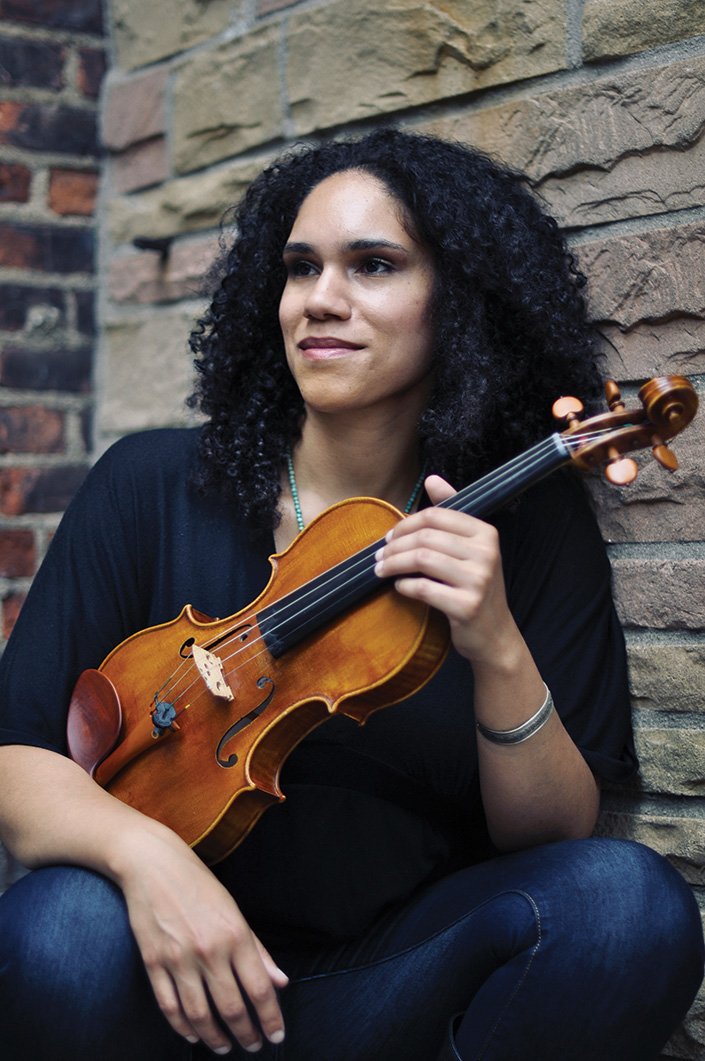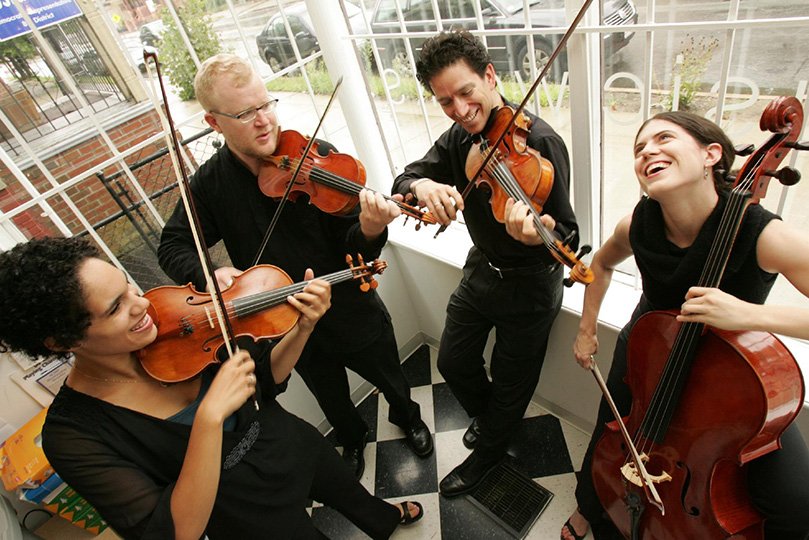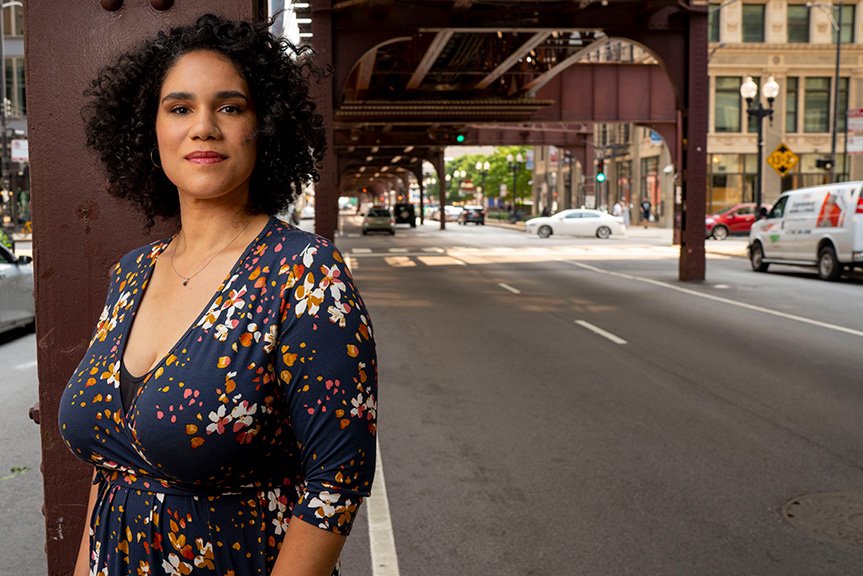By Kyle MacMillan
Jessie Montgomery is enjoying the kind of moment in the spotlight that every rising composer dreams of.
The 40-year-old Brooklyn native began a three-year stint last fall as composer-in-residence with the Chicago Symphony Orchestra. And in April, the ensemble presented the world premiere of Hymn for Everyone, the first of its three commissioned works by her.
In September, the New York Times profiled the multifaceted creator in a piece titled “The Changing American Canon Sounds Like Jessie Montgomery,” which hailed her “often personal yet widely resonant music—forged in Manhattan, a mirror turned on the whole country.”
(Photo: Jiyang Chen)
The composer’s first piano concerto, Rounds, was premiered in March by pianist Awadagin Pratt and the Hilton Head Symphony, which was part of a commissioning consortium that includes orchestras in Baltimore, Indianapolis, Milwaukee, and Kansas City, MO.
“It’s been a big year,” she acknowledged. And that momentum shows no signs of slowing down.
In addition to her work as a composer, Montgomery is also a violinist, activist, and educator. She will draw on all four career facets, especially the last, from June 27 through July 1, when she serves as composer-in-residence at the Ravinia Festival’s Steans Music Institute, one of the most sought-after summer training programs in the country. She will meet informally with this year’s 38 young professional piano and string musicians and coach 10 of them in three of her chamber works, Source Code (2013), Break Away (2013), and Peace (2020–22), which the participating musicians will perform in a free concert on July 2. [It can also be seen in a free stream on Ravinia’s YouTube channel, where it can be watched again after the live performance.]
“Having a direct line of communication,” Montgomery said, “between the composer and the music and the performer is a special thing. I want to be able to participate in that, and the best way to do that is by teaching.”
Although the orchestral version of Source Code will be prominently performed July 29 by Ravinia Chief Conductor Marin Alsop’s latest protégé, 2022 Taki Alsop Fellow Anna Duczmal-Mróz, and the Chicago Symphony Orchestra as part of the mini-festival Breaking Barriers: Women on the Podium—which also features one of her latest projects, a musical adaptation of Mo Willems’s children’s story Because, commissioned and premiered in March by the Kennedy Center, performed by conductor Jeri Lynne Johnson and the Chicago Sinfonietta on July 31—much of Montgomery’s work during her residency will be low-profile and out of view. And she is perfectly happy with that dichotomy.
While a resident musician at Community MusicWorks in Rhode Island from 2004 to 2009, Jessie Montgomery joined its Providence String Quartet (above), which commissioned her to write Anthem: A tribute to the historic election of Barack Obama during her final year. (Photo: Sandor Bodo)
Teaching has been an integral part of Montgomery’s career since she finished her undergraduate studies at New York’s Juilliard School and became a resident musician at Community MusicWorks, a nationally recognized music-education program in Providence, RI. In addition to holding the position of professor of violin and composition at The New School in New York City, where she resides, she has also taught at the Sphinx Performance Academy, an intensive summer training program for string musicians ages 11–17 with an emphasis on cultural diversity. “Teaching is the way that you ensure the connection to the future,” she said.
Growing up on Manhattan’s Lower East Side, Montgomery started taking violin lessons when she was 4 at the Third Street Music School Settlement, and a little later began writing music as well. She thought that performing would always be the central focus of her musical life, and she has been a member of several ensembles, including the Providence String Quartet, an offshoot of Community MusicWorks; PUBLIQuartet; and Catalyst Quartet, which she co-founded but had to recently leave because of increasing demands on her as a composer.
Each of these groups not only served as the outlet and impetus for her music but they exposed audiences to her work and raised her visibility as a composer. The big turning point for her was Strum, which has gone through several iterations starting in 2006. Originally conceived as a cello quintet, a final version for string quartet was completed in 2012 and premiered by the Catalyst Quartet, which went on to record it three years later as part of an album of Montgomery’s best-known works to that point. The piece, which has also been arranged for string orchestra, caught on with other groups, and it has become her most frequently performed work so far.
“Turbulent, wildly colorful, and exploding with life, Strum sounded like a handful of American folk melodies tossed into a strong wind, cascading and tumbling joyfully around one another,” wrote music critic Stephen Brookes in a Washington Post review of the Catalyst Quartet in 2012.
“Wildly colorful and exploding with life” is a good description of much of Montgomery’s writing, which often merges Black musical idioms—rhythms, vocal lines, and harmonic language—into the world of classical music. For fun and sometimes inspiration, she regularly listens to jazz, big-band music, and works by French composers—Poulenc has been a recent favorite. At the same time, she tries to stay current with the world of R&B, including such current singers as Madison McFerrin (daughter of famed cross-genre vocalist Bobby McFerrin) and Emily King.
Since she wrote Strum, Montgomery has turned to writing more large-scale works, including two commissions in the works for the New York Philharmonic and Dallas Symphony, and she is incorporating more open, improvised sections in her music. “I’ve always had this idea,” she said, “that there could be multiple styles happening within one piece, and I think what’s changing is that I’m getting closer to a unified sound. That’s always what I’m going for.”
(Photo: Todd Rosenberg)
One of the challenges in classical music, according to Alejandra Valarino Boyer, the new director of the Steans Institute, is that a high percentage of regularly performed classical compositions are by dead composers. While it is possible to read their letters and peruse archival materials, it is impossible to converse directly with them. But the Steans composer-in-residence initiative, which dates to 1993 but has operated on a more or less regular basis since 2008, gives the participating instrumental and vocal fellows a rare chance to do just that—ask questions about original intent and interpretative possibilities. “That is highly valuable for a young artist,” Valarino Boyer said, “so they see how they are part of the music-making, of bringing that score to life, and have a conversation with the composer to really understand what he or she was considering and thinking about.” Among the composers who have visited the Steans Institute for varying lengths of time include Pulitzer Prize winners like William Bolcom, Aaron Jay Kernis, and Shulamit Ran as well as such other notables as Leon Kirchner, Libby Larsen, and Ramsey Lewis.
Montgomery was selected as this summer’s composer-in-residence by Miriam Fried, the respected violinist and pedagogue who has been the director of the Steans Institute’s Piano & Strings Program for nearly 30 years. Two of her students at the New England Conservatory chose to learn a piece by Montgomery that Fried didn’t know, and the violinist was taken with it. “She had a real flair for finding sounds on the instrument that I found very interesting,” Fried said. “And, so, I was intrigued, and I went and looked up what was available [by Montgomery].”
Anthony McGill plays an excerpt of Peace, one of Montgomery’s works featured on July 2. Originally written for RSMI alumna violinist Elena Urioste, it is also arranged for clarinet or viola and piano.
A big advantage with Montgomery, Valarino Boyer said, is that she is writing regularly and her works are heard all over the country. “It’s really exciting to have somebody who is prolific now,” she said, “not somebody who is budding or maybe was prolific a long time ago, but whose works are actively being played and heard. And on the top of that, what’s exciting about Jessie is that she is also an educator. She is currently teaching and is well in tune with what young musicians are going through today and what they are learning.”
Montgomery will be the first Black woman to serve as composer-in-residence at the Steans Institute, and Fried is eager for its fellows to draw on a perspective that remains all too rare in a field that has long been dominated by white men. “I told her,” Fried said, “I was interested in having conversations about: What is the role of the composer? How do we incorporate more women in the profession? What are the issues she confronted as a Black woman composer and what is that we can all do make it better?”
(Photo: Jiyang Chen)
The composer never set out to be an activist, but she has been thrown into that role by virtue of her race and gender, especially since the rise of the #MeToo and Black Lives Matter movements in recent years and the urgency for change they have spurred. “Ideally, when I was starting out,” Montgomery said, “I would have preferred to just to know 100 percent that everything that I’m doing is being supported because of the work itself and not those identifiers. But over the years, I’ve just had to make sense of it all and just trust that it was ‘both and,’ and that it is important in our society to have that representation. So, I’ve grown into it.”
Her advocacy has taken many forms, including serving on national panels, speaking out in the press, and curating events like MusicNOW, the Chicago Symphony’s contemporary music series at the Harris Theater for Music and Dance. As the orchestra’s composer-in-residence, she chooses the composers who are featured, and she has put an emphasis on those from under-represented groups. She has also been extremely involved with the Sphinx Organization, a Detroit-based group that promotes the participation of people of color in classical music, and is a recipient of the Sphinx Medal of Excellence. She has evolved from being a high-school competitor in the Sphinx Competition to touring with the Sphinx Virtuosi to teaching, as noted, at the Sphinx Performance Academy.
While Montgomery sees a more equitable mix of composers being showcased in the classical world and more groups taking a socially conscious approach to the artists they present, there still remain varying levels of commitment to inclusion and diversity. On positive side, she has been impressed, for example, by the long-term commitment that the Chicago Symphony has made to her, giving her a residency of three years and agreeing to commission three major orchestral works and some chamber music. Overall, despite continuing challenges, she is optimistic about the direction of change in the field.
“In general, I tend to focus on the positives,” she said. “That’s just my thing in life.”
Kyle MacMillan served as classical music critic for the Denver Post from 2000 through 2011. He currently freelances in Chicago, writing for such publications and websites as the Chicago Sun-Times, Early Music America, Opera News, and Classical





